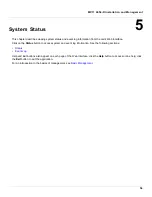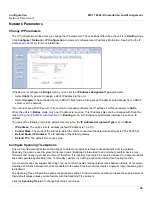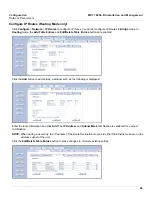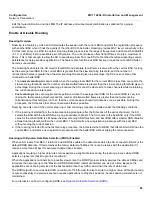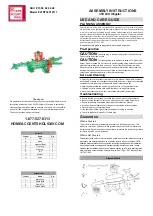
Configuration
MP.11 4954-R Installation and Management
Network Parameters
62
Network Parameters
Change IP Parameters
The IP Configuration window lets you change the IP parameters. These settings differ when the unit is in
Routing
mode.
Click
Configure
>
Network
>
IP
Configuration
to view and configure local IP address information. See
Setting the IP
Address with ScanTool
for more information.
If the device is configured in
Bridge
mode, you can set the
IP Address Assignment Type
parameter:
• Select
Static
if you want to assign a static IP address to the unit.
• Select
Dynamic
to have the device run in DHCP client mode, which gets an IP address automatically from a DHCP
server over the network.
If you do not have a DHCP server or if you want to manually configure the IP settings, set this parameter to
Static
.
When the unit is in
Bridge
mode, only one IP address is required. This IP address also can be changed with ScanTool
(see
Setting the IP Address with ScanTool
). In
Routing
mode, both Ethernet and Wireless interfaces require an IP
address.
You can set the following remaining parameters only when the
IP Address Assignment Type
is set to
Static
.
•
IP Address:
The unit’s static IP address (default IP address is 10.0.0.1).
•
Subnet Mask:
The mask of the subnet to which the unit is connected (the default subnet mask is 255.255.255.0).
•
Default Router IP Address:
The IP address of the default gateway.
•
Default TTL:
The default time-to-live value.
Configure Spanning Tree Options
This protocol is executed between the bridges to detect and logically remove redundant paths from the network.
Spanning Tree can be used to prevent link-layer loops (broadcast is forwarded to all port where another device may
forward it and, finally, it gets back to this unit; therefore, it is looping). Spanning Tree can also be used to create redundant
links and operates by disabling links: hot standby customer is creating a redundant link without routing function.
If your network does not support Spanning Tree, be careful to avoid creating network loops between radios. For example,
creating a WDS link between two units connected to the same Ethernet network creates a network loop (if spanning tree
is disabled).
The Spanning Tree configuration options are advanced settings. Proxim recommends that you leave these parameters at
their default values unless you are familiar with the Spanning Tree protocol.
Click the
Spanning Tree
tab to change Spanning Tree values.







